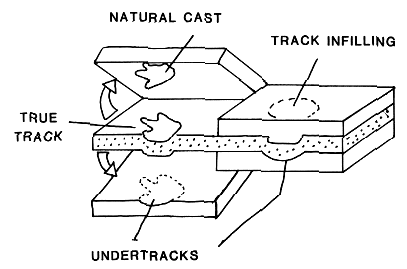|
Certain conditions must be present in order for a dinosaur track to be
preserved. Good imprints are made in moist, firm, fine-grained sediment.
The imprint then needs to remain exposed so that it has time to dry up
and harden. Once hard, the imprint is buried and lithified.
Finally, some process, such as erosion, takes place to re-expose the track
of the dinosaur footprint. The track can be preserved as either a
cast or a mold.
Another method for imprint formation is the undertrack. If the force of the dinosaur foot is strong enough, or the underlying strata are weak enough, then the footprint is echoed in the deeper layers. Since this print is already buried, the chance for preservation is higher and will be preserved even when the 'real' imprint at the surface is destroyed before it can be fossilized.
All tracks are preserved 'in situ'--meaning that they are fossilized in the same location they were formed; no transportation has taken place. Since the tracks were buried in situ, evidence of the paleoenvironment is true for both the sediment as well as the track-maker. |
